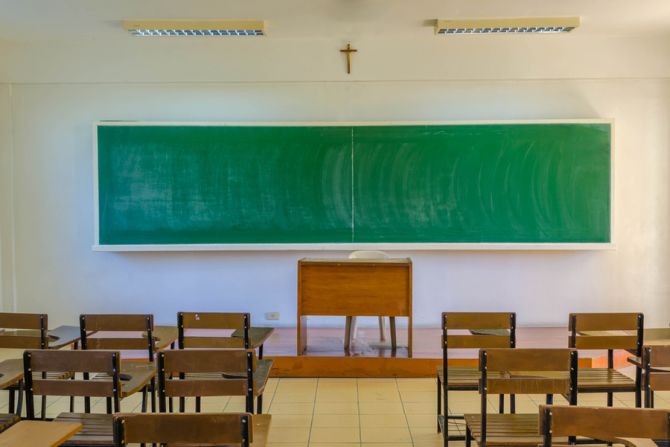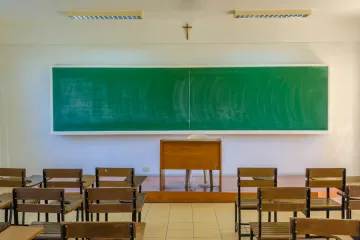Denver Newsroom, May 30, 2021 / 15:01 pm
Catholic school students in grades 4 and 8 are outperforming their public school peers in math, reading, and science, according to two recently released reports from the National Assessment of Educational Progress.
Math and reading are included in the most recent Digest of Education Statistics, published in February 2021 by the National Center for Education Statistics. The NAEP science scores were released Tuesday in conjunction with a press conference.
“Every year for the last 20 years, Catholic schools have outperformed public schools on NAEP tests—reading, math, science, computer literacy, geography, history,” said Sister Dale McDonald, PBVM, director of Public Policy and Educational Research for the National Catholic Education Association. “We’re happy to have our achievement validated by an outside, public, federal agency.”
NAEP, also known as The Nation’s Report Card, assesses academic achievement using the frameworks developed by the National Assessment Governing Board. The assessment measures student progress in grades 4, 8, and 12. Math and reading are scored on a scale of 0 to 500, while science is scored on a scale of 0 to 300.
“It’s important data for us to have as a system,” said Sister Dale. “It’s important that our schools are part of the national picture. We are 25 percent of the schools—that’s a significant part of the landscape.”
The most recent data sets compile assessment scores from 2019. Catholic school students in grades 4 and 8 were included in the assessment. Reporting standards for Catholic students in grade 12 were not met due to an insufficient sample size to permit a reliable estimate.
According to the report, Catholic school students in 4th grade achieved an average score of 235 in reading compared to 219 for their public school peers. Similarly, Catholic school 4th graders achieved an average score of 246 in math and 164 in science, compared to their public school peers, who achieved average scores of 240 and 150 respectively.
The distribution was similar for 8th grade, with Catholic school students outperforming their public school peers in reading with scores of 278 to 262, in math with scores of 293 to 281, and in science with scores of 167 to 153.
“I’m not recalling the exact findings, but, of course, the private schools, the Catholic schools always score higher,” said Peggy Carr, associate commissioner of the National Center for Education Statistics, in a press conference Tuesday. “It’s a matter of fact.”
The complete NAEP reports include average scores based on race/ethnicity, gender, eligibility for free/reduced-price school lunch, parental education, type of school, type of location, region, disability status, and English learners.
“This test is taken in the inner-city schools as well as the suburban, the rich and the poor,” said Sister Dale. “It's a tribute to our kids themselves that they do the work and take the test seriously.”
NAEP also measures historic trends in achievement for both public and private schools.
Between 2017 and 2019, there was a five-point decrease in the average reading score—from 283 to 278—for 8th grade Catholic school students. Public schools experienced a three-point decrease in reading during the same time period. In math, 8th graders dropped by one point—from 294 to 293—between 2017 and 2019, equal to their public school peers. The average score for science held steady at 167 in 2015 and 2019. Public school students also presented a steady science score at 153.
In Catholic school 4th grade, the average reading score remained at 235 between 2017 and 2019, compared to a two-point decrease in public schools. Average math scores increased by one point from 245 to 246 in Catholic schools, paralleling a public school increase from 239 to 240. In science, 4th grade students decreased from 167 to 164 between 2015 and 2019, reflecting a similar 3 point decrease in the public schools from 153 to 150.
“To sum up, the falling [science] scores of 4th grade students should be a wake up call for the nation,” said Cary Sneider, former member of the National Assessment Governing Board, in a press conference Tuesday.
Sneider suggested additional time for science in the school day as well as professional learning opportunities for teachers as one way to combat the decrease.
(Story continues below)
For Catholic schools, providing extra support is one way to continue achieving at high levels, said Sister Dale.
“We expect all kids to do well, to do the best that they can,” she said. “If it takes involving families, if it takes involving teachers for extra help, that’s what we’re there for.”
The current NAEP data was collected before the pandemic. No data was collected in 2021 because of the varied formats of learning during COVID-19. The next assessments will take place in 2022.
When asked about potential impacts of the pandemic during Tuesday’s press conference, James Lynn Woodworth, commissioner for the National Center for Education Statistics, said, “It’s reasonable to believe that the impact of covid will likely have a negative effect on achievement for students.”
“Once we see what impacts are, then we can start to look at ways to address the changes and the differences,” he said.
Sister Dale expects a similar impact on Catholic school student achievement, but she remains hopeful.
“The pandemic occurred for many of our schools during the first week of our spring break,” she said. “By the time break was over, teachers were ready to go and all students were online. In the fall, 92 percent of our schools were open.”
The schools that were not open in the fall of 2020 were not able to open because of state or local district guidelines, she said.
“We stand by our reputation of providing excellent academic opportunities for kids, along with spiritual development,” she said.






